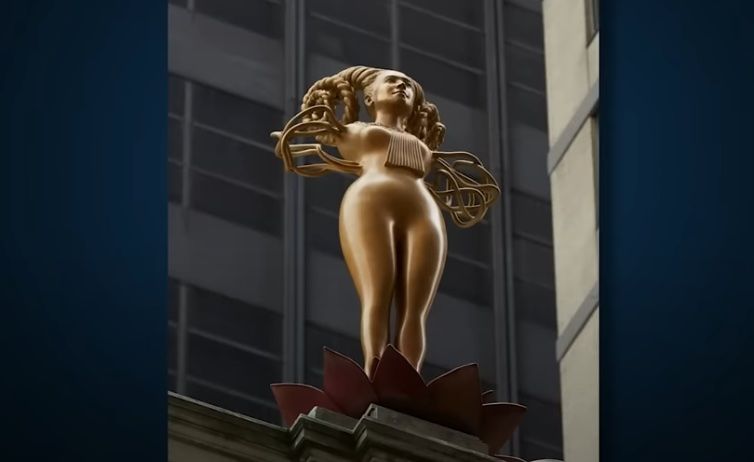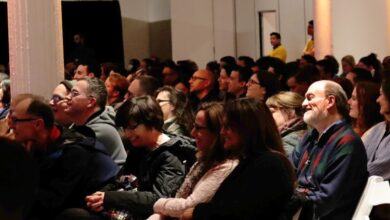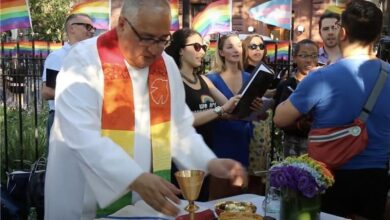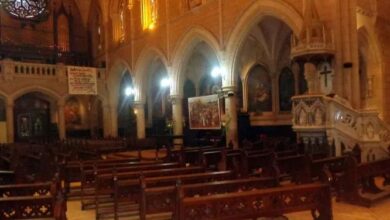How the ‘satanic’ New York City courthouse statue is all about abortion

 The golden-horned female statue titled “NOW” was made by Pakistani-born artist Shahzia Sikander. / Credit: Ben Shapiro/YouTube
The golden-horned female statue titled “NOW” was made by Pakistani-born artist Shahzia Sikander. / Credit: Ben Shapiro/YouTube Washington D.C., Jan 28, 2023 / 06:00 am (CNA).
An unusual new 8-foot-tall golden statue standing on top of a New York City courthouse has sparked controversy, with many across the country reacting to its unveiling with shock and disgust. One media outlet even called it a “satanic golden medusa.”
According to the artist who created the statue, it’s a symbol of women’s empowerment and an expression of support for abortion. The “satanic” imagery so many have pointed out closely resembles that employed by a pro-abortion group dedicated to banning religion from the public square.
What does the artist say?
The golden-horned female statue titled “NOW” was made by Pakistani-born artist Shahzia Sikander.
Sikander, 53, has been an influential New York City artist for years, serving on the Mayoral Advisory Commission on City Art, Monuments, and Markers in New York in 2017. A self-described “citizen of the world,” Sikander says her work is meant to take classical and Indo-Persian styles and imbue them with modern feminist inflections.
According to the artist, the statue was commissioned as part of “cultural reckoning” to better represent “21st-century social mores” in public spaces, the New York Times reported.
She described her statue as a “fierce woman” and a “form of resistance.”
The title “NOW” is meant to call attention to Sikander’s belief that fierce female resistance is needed now, after the death of the first female Supreme Court Justice Ruth Bader Ginsburg and since the national right to abortion was eliminated with the overturning of Roe v. Wade in June 2022.
The goat-like horns
Atop the head of the courthouse statue are large braids that curl in on themselves to form goat-like horns. According to Sikander, the horns signify “sovereignty” and “autonomy.”
On Fox News, commentator Tucker Carlson decried the statue as “demonic.”
The horned statue does bear a resemblance to the image of the goat-like “Baphomet,” used by The Satanic Temple (TST), a self-described “non-theistic” religious organization that frequently engages in political protests of expressions of religion in the public square.
The Satanic Temple, while employing satanic imagery, states in a FAQ on their website that they do not believe in Satan.
In recent years, TST has sued states with significant abortion restrictions, saying these laws violate the group’s “religious right” to practice its “abortion ritual.” The organization has also protested prayer in school and Christian-themed imagery displayed on public space.
The lace collar
The statue wears a lace collar around its neck, which Sikander has explained is meant to resemble the collar worn by the late Supreme Court Justice Ruth Bader Ginsburg.
Ginsburg, who died in 2020 and sat on the Supreme Court for 27 years, has come to be seen by many abortion activists, such as the group “Ruth Sent Us,” as a symbol of female empowerment and even abortion itself.
The “Ruth Sent Us” website states its mission is to fight what it calls “a racist and misogynistic theocracy” Supreme Court. The group has organized protests at Supreme Court justices’ homes and inside Catholic churches during Mass.
An ‘anti-monument’ monument
Since 1900, the New York City courthouse has displayed a collection of statues of men significant to the development of law, including Moses, Byzantine Emperor Justinian, and Confucius. The New York Times ran a glowing feature of the new statue, titled “Move Over Moses and Zoroaster: Manhattan Has a New Female Lawgiver.”
By depicting a naked, horned female image, Sikander said she meant to break from tradition.
“I have always had an affinity for the anti-monument in my practice,” Sikander explained in an artistic statement released on Madison Square Park Conservancy’s website.
Explaining the figure’s nakedness, Sikander said “the body is a powerful tool that carries its social construction. It can also function as a site of resistance.”
The statue rises atop a lotus flower, which Sikander described as “alluding to perception as illusion” and signifying “a deeper truth beyond its form.”
The sister statue ‘Witness’
The courthouse statue is one piece of a pair, with its sister statue “Witness” displayed in nearby Madison Square Park. The park statue is identical to its partner save for a hooped skirt, which is meant to resemble the dome of the New York City courthouse.
Along the figure’s hoop skirt are mosaic swirls that spell the word “Havah.” A Hebrew, Arabic, and Urdu word, translations for “Havah” vary.
To Sikander, translations of “Havah” as “to breathe,” “to be,” and the name “Eve” all fit her intention.
To her, “Havah” means “to breathe, to add air, to change a narrative.” The Art Newspaper reported that Sikander said she hopes her statues will be icons of resistance, saying, “Eve is also the first law-breaker, right?”
The two statues will remain in New York until June, when they will be placed on exhibit in Houston.






